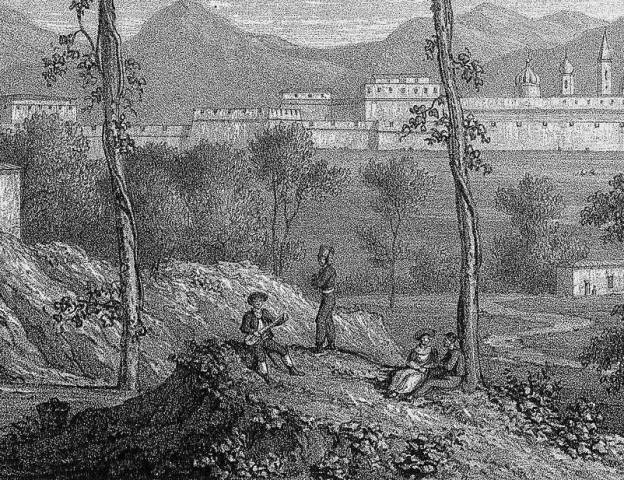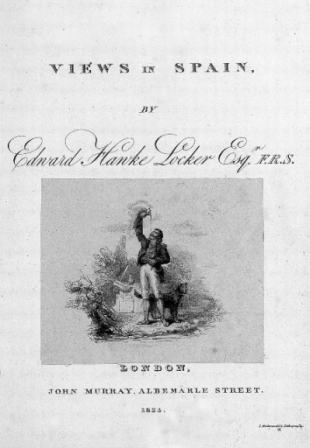The piece of the month of November 2010
VIEW OF PAMPLONA. 1824
Eduardo Morales Solchaga
Chairof Navarrese Heritage and Art
Lithographic print with an evocative and romantic veduta of Pamplona, made in the first quarter of the 19th century. In the foreground there is an interesting group of people resting under tall trees, between whose tops there is a complex network of crossbeams, which serve as a canopy. A couple converses in the shade of one of them, while two other individuals complete the scene, one plays the guitar, and the other, wearing a striking hat, fixes his gaze on the viewer. They stand on top of a hill, at the foot of which a large esplanade emerges, revealing in the background an imposing, though not very believable view of the capital of the Old Kingdom. Although the walls seem to conform to the style of the capital, the contour of it is dotted with Arabic-style buildings, with bulbous domes, which do not correspond to the reality of the city. Behind it the mountainous environment of the same one is appreciated, that in this case yes that reflects with enough fortune, the real status of Pamplona, being able to be identified, from left to right and with enough accuracy, some of the summits, peaks and places that surround the city: San Donato, the mount Gaztelu, the mount Vizcay, Ochovi, the mount Archueta, Irumugarrieta, Añézcar, Trinidad de Erga and mount Agüe. Regarding their position in relation to the landscape, it seems likely that they were taken from the slope of Mendillorri, somewhat above the weaving mill that was once located there, of which only its imposing chimney remains.
As can be seen in the upper right corner, it is part of a travel book, specifically "Views in Spain", published in the format of Issue in 1824, although it was published in installments during the previous year, coinciding with the irruption in the Peninsula of the Hundred Thousand Sons of St. Louis, in order to reinstate Ferdinand VIII and thus end the Liberal Triennium. It was at that time, when Spain was international news, that the astute publisher John Murray, whose name is shown in the center of the lower registration , took the opportunity to publish a book, of a markedly romantic character, with materials prepared years earlier by the author, Edward Hawke Locker, who also signed the composition, in this case on the right-hand side.

View of Pamplona. E.H. Locker and W. Westhall (1824)
Edward Hawke Locker (1777 - 1849) was an English artist and military sailor, who accompanied Admiral Pellew in the Mediterranean fleet during the Spanish War of Independence, arriving at the coast of Tarragona in June 1813. There he was commissioned to take some dispatches to Wellington, who was in Vera de Bidasoa. During the mentioned business, that occupied him until October of that year, he crossed very varied places, like Tarragona, Reus, Alforja, Fraga, Zaragoza, Tudela, Pamplona and Vera de Bidasoa, taking notes and news of them. After submit the dispatches, he visited many other places in Spain, proceeding in the same way, until he returned to Pellew's orders. The lithograph presented here is based on the notes taken by Locker in his first part of the trip, and, although he could not enter the city, occupied by the French, he did manage to describe its surroundings and its approximate morphology.

View of Pamplona. Detail
In the book "Views in Spain" his impressions are collected and a total of sixty plates of places, cities and towns of Spain, belonging to Catalonia, Aragon, Basque Country, Navarre, the two Castilles and Valencia are counted. In it one can find views in which other previous travelers, such as Laborde and Swinburne had not stopped, because as the great capitals were in French hands, he stopped in points of less strategic interest, far from the most habitual routes. For Navarre, apart from the present view, there were also lithographs of Tudela, Noain, Tafalla, Sorauren, Velate, Zozaya, Sumbilla and Vera de Bidasoa. In addition to his military ventures, Locker also belonged to the prestigious Royal Society (he signed the lithograph, F.R.S. - Fellow of the Royal Society -), and one of his main achievements was the foundation of a museum in Greenwich in which portraits of illustrious figures belonging to the English navy were exhibited. He was also the founder of the magazine "The plain englishman", of great importance in the London cultural circles of the time.

View of Pamplona. Credentials of authors and publisher
Once his prints and watercolors were delivered to John Murray, he hired a prestigious artist for their lithographic adaptation, William Westall (1781 - 1850), whose credentials are also shown on the left side of the registration. Born in Hertford, he was an English painter and engraver B , associate member of the famous Royal Academy (in fact, after his credentials on the engraving you can read A.R.A. - Associate Member of the Royal Academy-). As a young man he set his residency program in London where he began his programs of study engraving, and, at the age of nineteen, he was sent on an exploration to South Australia, where he took valuable and unpublished views. Later came trips to China, India, Jamaica and Madeira. Back in London, from the second decade of the 19th century, he received numerous commissions from local publishers, as is the case presented here, acquiring a B prestige until his death, the result of a domestic accident that had left him bedridden. It seems likely that he subjected Locker's notes to a certain evocative idealism, more to the taste of the romantic society of the time than the descriptive realism, already outdated, that was in vogue in the immediately preceding period.

Cover of "Views in Spain", London (1824)
The Issue to which the present lithograph belongs enjoyed B acceptance, very probably due to the magnificent plates that illustrated it, which in many occasions were segregated from it to be later framed. In fact, it is relatively easy to acquire, but not the complete Issue , of which only three are catalogued in Spain. The present lithograph is preserved in the file Municipal de Pamplona, although it is quite damaged and tastefully watercolored.
bibliography
- CABRA LAREDO, Mª D., "Una visión innovadora de la Guerra de la Independencia: Edward Hawke Locker" in Goya: Revista de Arte, nº 181 - 182 (1984), pp. 75 - 79.
- FREIXÁ, C., "Paisajes de España: entre lo pintoresco y lo sublime" [introductory study], Views in Spain, Barcelona, Ediciones del Serbal, 1998.
- GÓMEZ NAVARRO, J., "Los primeros viajeros románticos por España: Edward Hawke Locker" in Sociedad Geográfica Española, nº 12 (2002), pp. 52 - 63.
- LOCKER, E. H., "Views in Spain", London, John Murray, 1824.
- LOCKER, E.H., "Views in Spain" [prologue and introduction by María Dolores Cabra Laredo], Madrid, El Museo Universal, 1984.
- Oxford Dictionary of National Biography [online], biographies no. 101029107 and 101016893.
